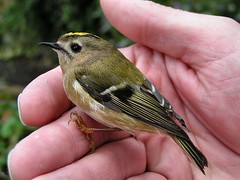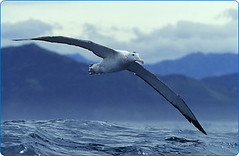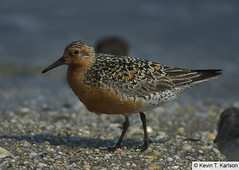Birds in the News #10
What do exploding toads, horseracing, birdcams and ultraviolet photoreceptors have to do with each other? You will learn the answers to this question and many more as you read week's Birds in the News! This week, my peeps and I found many wonderful stories to share with you, including updates on the ivory-billed woodpecker, an update on T-bill, the female mallard nesting near the nation's capital, and a story about the newest addition to the endangered California condor population.
If you have an interesting link to share or if you wish to contribute to the reader photoblog, feel free to email me at grrlscientist at yahoo.
Birds in Science:
 A few years ago, it was discovered that unlike humans, most bird species possess four color photoreceptors instead of three. Thus, birds can see ultraviolet light. What was the purpose of this extra photoreceptor? Apparently, this photoreceptor allows songbirds to flash secret sexual signals, signals that can only be seen by other birds who can see ultraviolet light. Pictured: a goldcrest, Regulus regulus, the smallest European bird and one of the "stars" of this story.
A few years ago, it was discovered that unlike humans, most bird species possess four color photoreceptors instead of three. Thus, birds can see ultraviolet light. What was the purpose of this extra photoreceptor? Apparently, this photoreceptor allows songbirds to flash secret sexual signals, signals that can only be seen by other birds who can see ultraviolet light. Pictured: a goldcrest, Regulus regulus, the smallest European bird and one of the "stars" of this story. The evidence suggests that at least some bird species can count. So how does a parasitic chick of another species convince its foster parents that they are still feeding their brood of hungry chicks, instead of one oversized intruder? It appears they use a wing patch as a visual cue: "The display of the wing patch might simulate extra gapes [open beaks] and so stimulate increased provisioning," write Keita Tanaka and Keisuke Ueda, biologists at Rikkyo University in Tokyo, Japan. Their paper was published in the journal, Science, and is reported here; full of deceit and murder, cuckoos reveal new disguise.
Tool-making birds are one thing, but when birds start making bombs, well, that is something worthy of concern. Like something out of a Hitchcock movie, it seems that birds may be behind those widely-reported exploding German toads.
Ivory-billed Woodpecker News:
The NY Times has a lengthy story about the recent rediscovery of the ivory-billed woodpecker, Campephilus principalis, including several wonderful photographs of the bird's habitat and Audubon's painting of a trio of these lovely birds. (This story requires free registration).
If you are a birder who owns the Sibley Field Guide to the Birds of North America, the ivory-billed woodpecker supplement is now available for download.
Additionally, a book about the search for the ivory-billed woodpecker is newly available, The Grail Bird by Tim Gallagher, one of the search party members. Needless to say, I am eagerly awaiting my copy of this book, which should arrive in the mail any day now.
A birder, Mary Scott, whose website I linked to in my original blog entry about the ivory-billed woodpecker, claims in this newspaper story that she saw the bird in 2003 in the White River National Wildlife Refuge in Arkansas.
People Helping Birds:
And for more news about T-bill, the female mallard, Anas platyrhyncos, nesting outside of the Treasury Building, next door to the White House, in Washington, DC. She successfully hatched all of her eleven eggs on Saturday. Momma and ducklings were captured and transported by motorcade to a nearby pond, Rock Cedar Park. Details about the drama endured by duckling number 11 are especially cute. This story includes MSN video that is horribly biased against Macs.
What is an endangered Laysan albatross, Phoebastria immutabilis, doing in downtown Seattle? No one knows for sure, but some people suspect that this pelagic seabird, which was thin and waterlogged, hitched a ride on a ship. The bird is being shipped to Sacramento for further rehab before it is released at sea. The story includes a photograph of this lovely bird.
 While we watch the 131st Kentucky Derby this Saturday in the US, racing fans, birders and bettors in Australia and the UK are watching the second annual Great Bird Race, run by the Tasmanian State Government, Conservation Foundation and Ladbrokes (Ladbrokes Worldwide is the betting and gaming division of Hilton Group plc.). This is the most creative idea I've heard about for raising money to protect endangered birds -- raising money from race bettors. The "race" itself is actually the annual westward migration of albatross species wearing "electronic jockeys" (satellite transmitters) and "owned" by celebrities such as Australian singer Olivia Newton-John. The winning bird is either the first to cross 31 degrees east longitude at Durban, South Africa, or it is the bird that has traveled the furthest distance west by 4 August.
While we watch the 131st Kentucky Derby this Saturday in the US, racing fans, birders and bettors in Australia and the UK are watching the second annual Great Bird Race, run by the Tasmanian State Government, Conservation Foundation and Ladbrokes (Ladbrokes Worldwide is the betting and gaming division of Hilton Group plc.). This is the most creative idea I've heard about for raising money to protect endangered birds -- raising money from race bettors. The "race" itself is actually the annual westward migration of albatross species wearing "electronic jockeys" (satellite transmitters) and "owned" by celebrities such as Australian singer Olivia Newton-John. The winning bird is either the first to cross 31 degrees east longitude at Durban, South Africa, or it is the bird that has traveled the furthest distance west by 4 August.This opinion piece tells a little about the history of birding in the Pacific Northwest and how the Seattle Audubon Society's brief radio program, BirdNote, is providing a platform for increasing people's awareness and appreciation for birds. The Seattle chapter of the National Audubon Society is one of the most creative and progressive in the country, with an enthusiastic and involved membership, and this radio show is a wonderful template that could be emulated elsewhere.
The Seattle Audubon Society is not the only group who is working to increase people's appreciation for birds. In this story, pioneers break new bird-watching ground, we learn that BirdLife South Africa is helping to increase birdwatching in Soweto by sponsoring their first National Bird Week. Why care about birds? "You can use birds as an indicator of the healthiness of the environment, and birds can be used scientifically for the good of mankind," says Jabulani Banda, chairperson of BirdLife Soweto.
This is the most beautiful map of migratory bird routes I've ever seen. In honor of spring migration, the Boreal Songbird Initiative (BSI) posted this new guide to Boreal birds, which is the most extensive webbed resource available about birds that rely on the Boreal. BSI has also provided a link to the new report by Dr. Peter Blancher of Bird Studies Canada that shows us this region is more important to birds than anyone had previously imagined: Nearly 50% of the continent’s bird species depend on the Boreal! This map, another brilliant example of the power of internet-based information technology, was created by eNature/NWF and is supported by the Pew Charitable Trusts.
Santa Cruz Predatory Bird Research Group has a wonderful website full of information for raptor-philes, including an online raptor quiz, a prairie falcon puzzle, and a peregrine cam focused on a pair of peregrines nesting on the 33rd floor of the Pacific Gas and Electric Company building in downtown San Francisco.
A rare California condor chick, Gymnogyps californianus, recently pecked its way out of its egg at the Oregon Zoo's captive breeding compound, bringing the known number of this endangered species to 245. In the early 1980s the known California condor population plunged to 22. Their population numbers are being recovered through captive breeding.
People Hurting Birds
In a startling development that could destroy part of the limited forest habitat favored by the Mauritius kestrel, Falco punctatus, a South-Eastern Highway is being constructed through the Mauritius east coast mountains' "Important Bird Area" (IBA). The Mauritius kestrel is one of the world’s flagship conservation success stories, recovering from being declared the rarest bird in the world in the 1970s to its present population levels between 800 and 1000 individuals. Which leads me to ask; how can they justify throwing away all their hard work when this bird has been doing so well?
Closer to home, the white-tailed ptarmigan, Lagopus leucurus, is critically imperiled in the southernmost parts of its range in New Mexico's Sangre de Cristo Mountains. This bird is being driven to extinction due to livestock overgrazing of public lands and increased recreational use of mountain peaks, despite the extreme conditions prevailing there.
As research funding for pest control dries up, New Zealand's National Bird, the brown kiwi, Apteryx mantelli, could be a big loser. The kiwi is a ratite (ratites also include ostrichs, emus and cassowaries), a flightless bird that is being driven to extinction by introduced predators such as the stoat (also known as the ermine, Mustela erminea, it is a member of the weasel family), possums, dogs, wild pigs and feral cats, all of which kill and eat kiwi chicks.
 The lovely and endangered red knot, Calidris canutus, is slipping alarmingly close to extinction. The red knot is a rusty-plumed shorebird that has one of the longest migrations on the planet - from Tierra del Fuego on the tip of South America to the Arctic, a round-trip of close to 20,000 miles. These birds spend their winter in Chile, migrate north, and stop at Delaware Bay to refuel before they continue on to their breeding grounds in the artic. The latest population count from Tierra del Fuego in February was just 17,600 birds -- 13,000 fewer birds than last year. Sadly, this rapid decline places them squarely on track for extinction by 2010. This story has many links including a streaming multimedia show featuring interviews with the international team of ornithologists and veterinarians involved and even sound tracks of calling red knots -- will they become voices from the dead? This Philadelphia Inquirer news series requires free registration (well worth it, too!). Photograph: linked from All About Birds (Cornell Laboratory of Ornithology).
The lovely and endangered red knot, Calidris canutus, is slipping alarmingly close to extinction. The red knot is a rusty-plumed shorebird that has one of the longest migrations on the planet - from Tierra del Fuego on the tip of South America to the Arctic, a round-trip of close to 20,000 miles. These birds spend their winter in Chile, migrate north, and stop at Delaware Bay to refuel before they continue on to their breeding grounds in the artic. The latest population count from Tierra del Fuego in February was just 17,600 birds -- 13,000 fewer birds than last year. Sadly, this rapid decline places them squarely on track for extinction by 2010. This story has many links including a streaming multimedia show featuring interviews with the international team of ornithologists and veterinarians involved and even sound tracks of calling red knots -- will they become voices from the dead? This Philadelphia Inquirer news series requires free registration (well worth it, too!). Photograph: linked from All About Birds (Cornell Laboratory of Ornithology). Bird Festivals:
Even though I live on the east coast, I have attended (several times) the annual Grays Harbor National Wildlife Refuge Shorebird Festival in Washington State. If you love watching shorebirds and their avian predators, then this is the festival to attend because it has everything for the shorebird lover. On The Wing has released a short audio file for the festival, featuring an interview with Refuge Biologist Marian Bailey.
Previous : : Birds in the News : : Next
Non-academic Interviews: 1 (this afternoon)
Academic Job Rejections: 1 (Assistant Professor of Biology)
Non-academic Rejections: 1 (staff science writer -- they say I don't have enough marketing experience)
© 2004, 2005, 2006 by GrrlScientist











8 Peer Reviews:
Very sad to hear about the red knot...I had no idea. I do see them very rarely, out here on the West Coast...
Plenty of great links here. The map is spectacular. I also really like the BirdNote site.
So, you would recommend going to Gray's Harbor. We may have to do just that.
Thanks for all the bird news.
I also have seen red knots on the west coast .. do you think that maybe we saw the same birds in different locations, Phila?? and I also am saddened to hear that they are in such grave peril. I hope other people share this feeling and are motivated to help this lovely shorebird to survive. (A big step along the way is to leave the hoseshow crabs alone, sheesh). Dr. Charles; I used the avian photoreceptor story as my final example in my vision lecture to my nursing students. I think they enjoyed it. Rexroth's Daughter; I would highly recommend attending the Gray's Harbor shorebirding festival. But I am selfish because I also look forward to your blog essay and photos after you return (yes, I enjoy feeling homesick, can you tell??)
Saint Nate: oddly, I did not even get an interview for that position. In fact, I applied for it in early January, so I was surprised to get a rejection letter because I'd forgotten I even applied for it. But that rejection letter was unique among the many (hundreds?) I've received; first, it is the first non-academic rejection letter I've ever received and second, it actually gave me a reason for my rejection. Nevernmind that I thought the reason was totally ridiculous, but it was a reason nonetheless.
GrrlScientist
Wow, thanks for the recommendation, I added it to my "other blogs read" section! I was especially impressed with the author's description of the prothonotary warbler's color and I chuckled over his friend, Mary's, conviction that the bird's name was the Pythagorean warbler.
GrrlScientist
Peter Cashwell does have a certain way with words.
I don't share your interest in birds, but even I found his book enjoyable, and it's not just because of me knowing him online (and having stayed at his place when travelling the US - giving him about 2 hours of warning, before staying there for several days).
Martha Stewart had him on her show promoting his book, which she apparently also liked (can't see her show here in Denmark, so I have only other peoples' report to go by), so it would appear that it has a fairly broad appeal.
Glad you are feeling better. I'm trying to catch up on all the bird news around here now that I have recovered from my final examinations. I'm taking really easy (to me) courses this summer so I have a small amount of intellectual stimulation while I prepare for a challenging fall semester.
You have a real gift, Hedwig, for making complex scientific information understandable without sacrificing content or "sexing" it up. I'm still keeping my fingers crossed that you will find something in your field soon.
I am glad that you told me about the link and the book. Kristjan. Hopefully, I will be able to find a copy of my own!
It's good to hear from you again, at long last, Miranda. Thanks for your kind words, I hope that something works out for me in the "job department", too.
That was a lovely photo of the albatross. I have seen Royal albatrosses at sea, off the east coast of New Zealand's South Island, and they are utterly unforgettable (even to this non-birder).
The first time I saw one, it was resting on the waves some distance from our ship. I couldn't believe what I was seeing - that something so huge could be a bird. It looked the size of a Cessna. As we sailed past, it took flight and I think everyone on that ship felt their heart rise into the sky with it. I've never seen anything so magnificent or imagined that such a huge creature could be so graceful or so much a part of the air it was travelling.
If you could see the wind, it would look like an albatross in flight.
--WW32
Post a Comment
<< Home